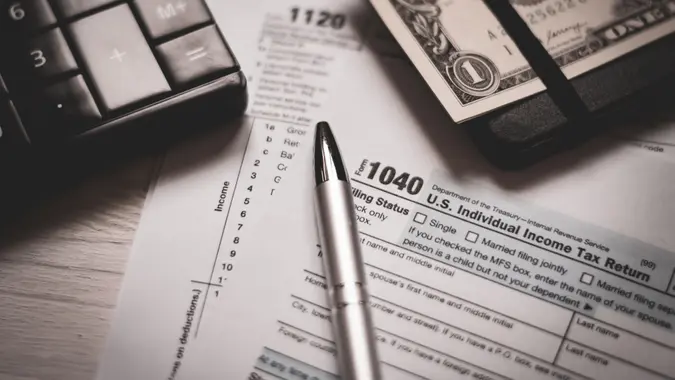How Much Does the Average Middle-Class Person Pay in Taxes?

Commitment to Our Readers
GOBankingRates' editorial team is committed to bringing you unbiased reviews and information. We use data-driven methodologies to evaluate financial products and services - our reviews and ratings are not influenced by advertisers. You can read more about our editorial guidelines and our products and services review methodology.

20 Years
Helping You Live Richer

Reviewed
by Experts

Trusted by
Millions of Readers
When we think about the U.S. standard of living, one of the key factors to consider is how much people earn in income, pay in taxes, and receive in government transfers. For middle-class Americans, understanding the tax burden is crucial as it directly impacts their disposable income and overall financial health. Let’s dive into how much the average middle-class person pays in taxes and what this means for their finances.
Average Tax Burden for Middle-Class Families
In 2021, the average American family in the middle 20% of income earners paid $17,902 in taxes to federal, state, and local governments. This amount includes both direct taxes, such as income taxes, and indirect taxes, like payroll taxes.
- Federal Income Tax: Of the total taxes paid, $10,391 went to federal income tax.
- Total Taxes: Including federal, state, and local taxes, the average middle-class family paid $17,902.
To be in the middle 20% of income earners, a family would need to have a market income between $41,900 and $80,000. The average income for families in this group was $59,757 in 2021.
Tax Distribution Across Income Percentiles
Here’s a breakdown of the tax burden across different income groups:
| Income Percentile | Total Taxes Paid (Federal, State, Local) | Federal Taxes Paid |
|---|---|---|
| Bottom 20% | $4,210 | $1,070 |
| Second 20% | $9,030 | $4,280 |
| Middle 20% | $17,902 | $10,391 |
| Fourth 20% | $33,090 | $20,810 |
| Top 20% | $139,400 | $95,090 |
These figures highlight how the tax burden increases significantly with income, illustrating the progressive nature of the U.S. tax system.
Government Transfers
In addition to paying taxes, middle-class families also receive government transfers, which can help offset their tax burden. In 2021, the average family in the middle 20% received $30,033 in government transfers. These transfers include benefits such as Social Security, Medicare, and Medicaid.
Middle-Class Income Tax Brackets
Understanding tax brackets is essential for middle-class earners to comprehend their tax obligations:
- 10% Tax Bracket: The first portion of income is taxed at 10%.
- 12% Tax Bracket: The next portion is taxed at 12%.
- 22% Tax Bracket: For many middle-class earners, a significant portion of income falls into the 22% tax bracket.
- 24% and 32% Tax Brackets: Higher earners within the middle class may see portions of their income taxed at these rates.
This progressive tax system means that as income increases, the rate at which it is taxed also increases, but not all income is taxed at the highest rate reached.
Perception vs. Reality
Many Americans believe they pay too much in federal income taxes. According to a poll from AP-NORC, about 60% of adults mistakenly think that middle-income households pay the highest tax burden. In reality, high-income Americans bear the largest share of the federal tax burden. The top 50% of earners pay nearly 98% of the nation’s federal taxes, while the bottom 50% contribute about 2.3%.
Conclusion
For the average middle-class family, the tax burden is significant but manageable, especially when considering the benefits received through government transfers. While federal, state, and local taxes add up, these contributions help support essential services and programs that benefit all citizens.
Understanding your tax obligations and how they fit into the broader economic picture can help middle-class earners better manage their finances and plan for the future. For personalized financial advice and strategies to optimize your tax situation, consider consulting with a financial advisor.
Editor's note: This article was produced via automated technology and then fine-tuned and verified for accuracy by a member of GOBankingRates' editorial team.
More From GOBankingRates
 Written by
Written by  Edited by
Edited by 

























